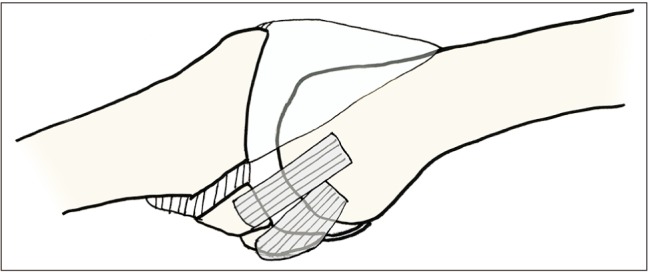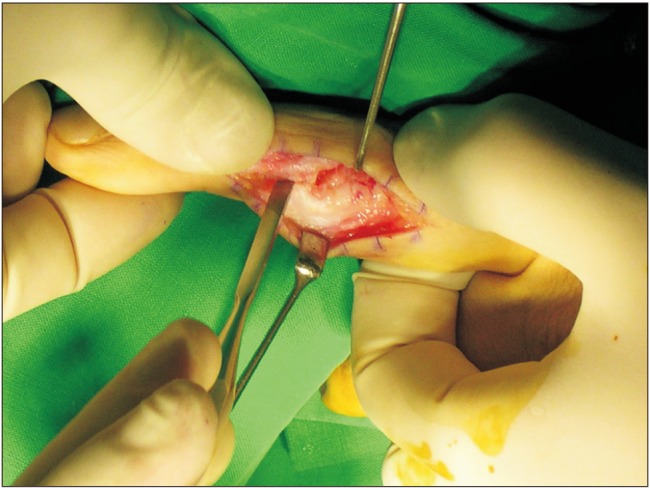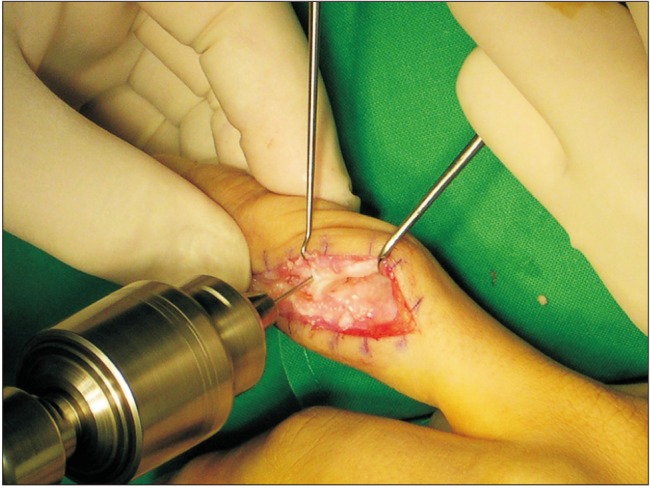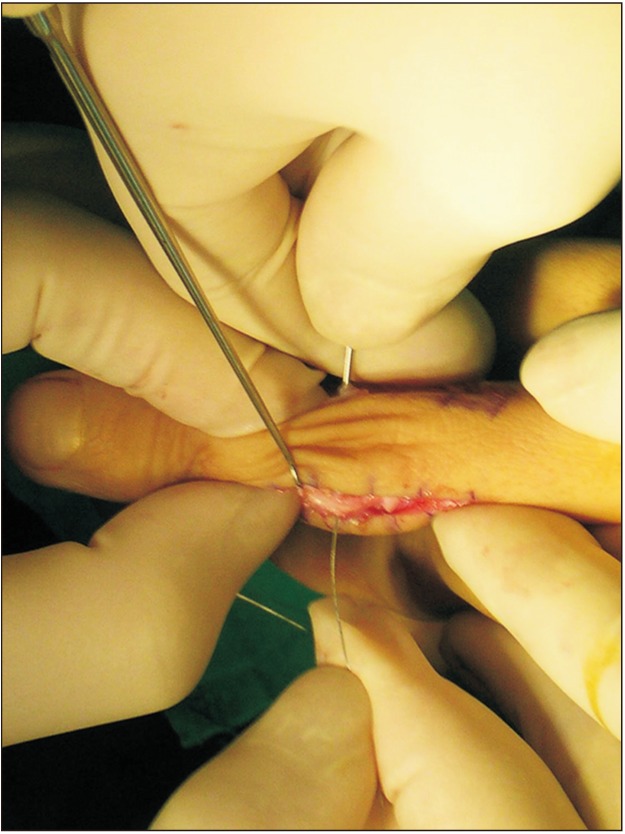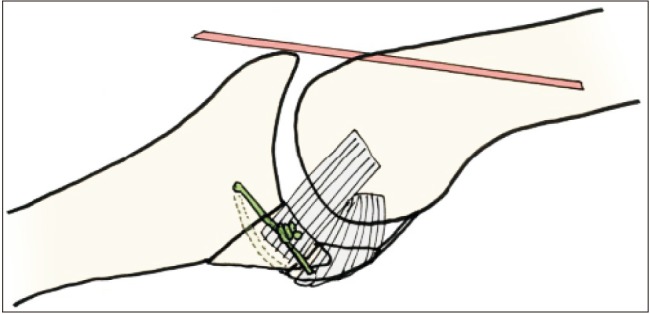Clin Orthop Surg.
2019 Jun;11(2):220-225. 10.4055/cios.2019.11.2.220.
Modified Transosseous Wiring Technique for Neglected Fracture–Dislocation of the Proximal Interphalangeal Joint
- Affiliations
-
- 1Department of Orthopaedic Surgery, Kyungpook National University Hospital, School of Medicine, Kyungpook National University, Daegu, Korea. hjleee@knu.ac.kr
- 2Daegu Park's Hospital, Daegu, Korea.
- 3Department of Anatomy, School of Medicine, Kyungpook National University, Daegu, Korea.
- 4Bio-Medical Research Institute, Kyungpook National University Hospital, Daegu, Korea.
- 5Department of Orthopaedic Surgery, Keimyung University Dongsan Medical Center, Daegu, Korea.
- KMID: 2445058
- DOI: http://doi.org/10.4055/cios.2019.11.2.220
Abstract
- BACKGROUND
Fracture-dislocation of the proximal interphalangeal (PIP) joint of the finger is challenging due to the high risk of stiffness. The purpose of this study is to evaluate the clinical and radiological results of a modified transosseous wiring technique for the management of chronic fracture-dislocations of the PIP joint.
METHODS
Ten patients (nine men and one woman; mean age, 38.3 years; range, 21 to 69 years) with neglected fracture-dislocation of the PIP joint were included. The mean duration from injury to operation was 14.7 weeks (range, 3 to 66 weeks). The dorsolateral approach and extension block pinning were used to reduce dislocation. After thorough debridement of the scar tissues in the dorsal dead space and the fracture site, the reduction was maintained with transosseous wiring. Radiologic evaluations of bone union and arthritic changes and clinical evaluations (range of motion of the PIP joint and Disabilities of the Arm, Shoulder and Hand [DASH] score) were performed. The mean follow-up period was 12.9 months (range, 12 to 19 months).
RESULTS
All patients demonstrated evidence of radiographic healing within a mean healing time of 6 weeks (range, 4 to 10 weeks); however, one had a widened gap and one had an early arthritic change. The mean range of motion in the PIP joint was 81° (range, 50° to 105°). The mean DASH score was 21.6 (range, 7.5 to 35.8).
CONCLUSIONS
For chronic fracture-dislocation of the PIP joint, transosseous wiring with direct curettage and optimal bone purchase can provide satisfying outcome.
Figure
Cited by 1 articles
-
Transosseous wiring method for simple transverse shaft fracture of the upper extremity
SeongJu Choi, Sung Youn Jung, Min Bom Kim
Arch Hand Microsurg. 2024;29(1):34-39. doi: 10.12790/ahm.23.0039.
Reference
-
1. Shen XF, Mi JY, Rui YJ, et al. Delayed treatment of unstable proximal interphalangeal joint fracture-dislocations with a dynamic external fixator. Injury. 2015; 46(10):1938–1944. PMID: 26144906.
Article2. Weiss AP. Cerclage fixation for fracture dislocation of the proximal interphalangeal joint. Clin Orthop Relat Res. 1996; (327):21–28. PMID: 8641066.3. Tang JB, Avanessian B. New tendon, nerve, and bone surgical methods impacting the practice of hand surgery. Clin Plast Surg. 2014; 41(3):xix–xx. PMID: 24996477.
Article4. Ng CY, Oliver CW. Fractures of the proximal interphalangeal joints of the fingers. J Bone Joint Surg Br. 2009; 91(6):705–712. PMID: 19483220.
Article5. Finsen V. Suzuki's pins and rubber traction for fractures of the base of the middle phalanx. J Plast Surg Hand Surg. 2010; 44(4-5):209–213. PMID: 21446818.
Article6. Bhatt RA, Schmidt S, Stang F. Methods and pitfalls in treatment of fractures in the digits. Clin Plast Surg. 2014; 41(3):429–450. PMID: 24996463.
Article7. Cheah AE, Tan DM, Chong AK, Chew WY. Volar plating for unstable proximal interphalangeal joint dorsal fracture-dislocations. J Hand Surg Am. 2012; 37(1):28–33. PMID: 22018477.
Article8. Freiberg A. Management of proximal interphalangeal joint injuries. Can J Plast Surg. 2007; 15(4):199–203. PMID: 19554177.
Article9. Ishida O, Ikuta Y. Results of treatment of chronic dorsal fracture-dislocations of the proximal interphalangeal joints of the fingers. J Hand Surg Br. 1998; 23(6):798–801. PMID: 9888686.
Article10. Criner KT, Ilyas AM. Silicone arthroplasty for chronic proximal interphalangeal joint dislocations. Tech Hand Up Extrem Surg. 2011; 15(4):209–214. PMID: 22105631.
Article11. Calfee RP, Kiefhaber TR, Sommerkamp TG, Stern PJ. Hemihamate arthroplasty provides functional reconstruction of acute and chronic proximal interphalangeal fracture-dislocations. J Hand Surg Am. 2009; 34(7):1232–1241. PMID: 19700071.
Article12. Jones BF, Stern PJ. Interphalangeal joint arthrodesis. Hand Clin. 1994; 10(2):267–275. PMID: 8040205.
Article13. Hierner R, Berger AK. Long-term results after vascularised joint transfer for finger joint reconstruction. J Plast Reconstr Aesthet Surg. 2008; 61(11):1338–1346. PMID: 17996505.
Article14. Yabe Y. Open reduction for chronic PIP joint dorsal fracture dislocation. Seikei Geka. 1976; 27:1435–1439.15. Schenck RR. Classification of fractures and dislocations of the proximal interphalangeal joint. Hand Clin. 1994; 10(2):179–185. PMID: 8040196.
Article16. Stern PJ, Roman RJ, Kiefhaber TR, McDonough JJ. Pilon fractures of the proximal interphalangeal joint. J Hand Surg Am. 1991; 16(5):844–850. PMID: 1940163.
Article17. Liodaki E, Xing SG, Mailaender P, Stang F. Management of difficult intra-articular fractures or fracture dislocations of the proximal interphalangeal joint. J Hand Surg Eur Vol. 2015; 40(1):16–23. PMID: 25427554.
Article18. de Haseth KB, Neuhaus V, Mudgal CS. Dorsal fracture-dislocations of the proximal interphalangeal joint: evaluation of closed reduction and percutaneous Kirschner wire pinning. Hand (N Y). 2015; 10(1):88–93. PMID: 25767425.19. Vitale MA, White NJ, Strauch RJ. A percutaneous technique to treat unstable dorsal fracture-dislocations of the proximal interphalangeal joint. J Hand Surg Am. 2011; 36(9):1453–1459. PMID: 21820818.
Article20. Ruland RT, Hogan CJ, Cannon DL, Slade JF. Use of dynamic distraction external fixation for unstable fracture-dislocations of the proximal interphalangeal joint. J Hand Surg Am. 2008; 33(1):19–25. PMID: 18261660.
Article21. Agee JM. Unstable fracture dislocations of the proximal interphalangeal joint: treatment with the force couple splint. Clin Orthop Relat Res. 1987; (214):101–112. PMID: 3791731.22. Agee JM. Unstable fracture dislocations of the proximal interphalangeal joint of the fingers: a preliminary report of a new treatment technique. J Hand Surg Am. 1978; 3(4):386–389. PMID: 681726.
Article23. Merrell G, Slade JF. Dislocations and ligament injuries in the digits. In : Wolfe SW, Hotchkiss RN, Pederson WC, Kozin SH, editors. Green's operative hand surgery. New York, NY: Churchill Livingstone;2005. p. 308.
- Full Text Links
- Actions
-
Cited
- CITED
-
- Close
- Share
- Similar articles
-
- Fracture Dislocation of the interphalangeal Joint of Great Toe: Report of Three Cases
- Treatment of Neglected Proximal Interphalangeal Fracture Dislocation Using a Traction Device: A Case Report
- Treatment of Fracture - Dislocation of the Proximal Interphalangeal Joint
- Open Reduction of a Dislocation of the Interphalangeal Joint of the Great Toe Neglected for 6 Weeks
- Irreducible Open Dorsal Dislocation of the Proximal Interphalangeal Joint: A Case Report

